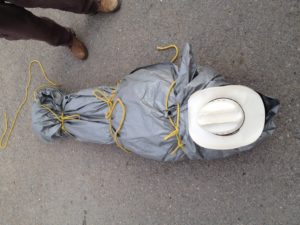Weather and water can be unpredictable, and often paddlers are caught off-guard by an unexpected storm or an unplanned swim. With cold related problems, good prevention is key, and understanding how to manage hypothermia is an important skill for guides and paddlers alike. Different texts define the stages of hypothermia in slightly different ways, the discussion below focuses on the signs that may be visible in your guests and paddling partners.
Keep in mind the 4 ways that a body can loose heat:
- Radiation – we “emit’ heat much like the sun gives off heat
- Convection – heat loss is 25x greater when submersion in water.
- Evaporation – moisture interacting with air and thus reducing body temperature (sweating or splashes on the skin)
- Conduction – contact will transfer heat until the temperatures reach equilibrium
In the early stages of hypothermia the patient is awake and visibly cold; their body is burning any available ‘fuel’ and is taking steps to stay warm. Remember that shivering is a way for the body to try and create heat.
The “umbles” As heat loss eclipses heat production, the body starts to prioritize blood flow to the core of the body and decreases circulation to the extremities resulting in loss of fine motor skills (dexterity) and speech. We call the resulting signs the umbles; mumbling, stumbling, bumbling and fumbling.
Hypothermia is life threatening, and if a person continues to loose heat, the core temperature will to drop as hypothermia progresses into later stages. Shivering will become violent and uncontrollable before it eventually stops. As the body’s last-ditch effort to warm itself is exhausted more pronounced changes in the level of consciousness are visible.
If your patient is awake, get the person up and moving to increase metabolic output. Give this person fluids and feed him/her, starting with simple carbs and then progress to more complex foods. The best way to start warming someone up is from the inside out, starting his or her internal engine. Prevent further heat loss by removing any wet clothes and replacing them with dry insulating layers. Don’t forget that even a small thin wet layer can continue to suck heat out of the patient. Use of a hypo-wrap with vapor barriers and waterproof materials can help keep heat in, and radiant heat sources can be added such as warm water bottles or rocks.
Lastly, here are a few hypothermia tips for commercial raft guides
- If you are cold as the guide, your guests are freezing. Remember they get the brunt of the water and splash and are cold.
- Keep guests hydrated and fed even on warmer trips to keep those fuel sources stocked.
- Assess your crew and identify poor layering choices like cotton before hitting the water.
- Look for the signs and catch it early.
Hypothermia can strike anywhere anytime, and given the temperature of the water that people flock to for recreation, it always a potential problem. Have the right gear, and be aware of problems before they arise.


